The Lungs - (GCSE Biology)
The Lungs
The Lungs
We will now move on to learning about the lungs. Remember,
deoxygenated blood is pumped to the lungs, where it can get oxygen
via gas exchange.
- Pulmonary arteries – the blood passes from the heart into the pulmonary artery, and then into pulmonary capillaries.
- Pulmonary capillaries – the pulmonary capillaries come into contact with small air sacs in the lungs called alveoli, where gas exchange takes place.
- Pulmonary veins – the oxygenated blood then travels back to the heart via pulmonary veins.
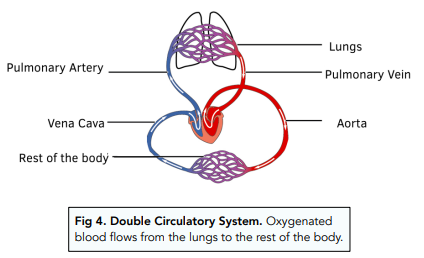
EDIT CAPTION FIG NO.
Functions of the Lungs
The lungs has two key jobs:
- Ventilation – air needs to be moved in and out of the lungs. Oxygenated is moved in, and then gas exchange happens, and then the now deoxygenated air is moved out.
- Gas Exchange – there is gas exchange between the oxygenated air in the alveoli, and the blood in the pulmonary capillaries. There is movement of oxygen from the air into the blood and move carbon dioxide away the blood into the air.
Structure of the Lungs
Lungs take up a large amount of space in the body. The lungs are in the human thorax and are surrounded by pleural membranes. This is the top half of the body, roughly the area of your rib cages. This is the route of air through the lungs:
- Mouth and Nose. Air enters the lungs through the mouth and nose
- Trachea. Air passes into the trachea, which is a big central tube.
- Bronchi. The trachea splits into two tubes called bronchi, which go to the left and right lungs.
- Bronchioles. Each bronchus splits into lots of smaller tubes called bronchioles, which move through the lungs.
- Alveoli. Each bronchiole ends in lots of small air sacs called alveoli.The alveoli come into close contact with the pulmonary capillaries,
so the alveoli are specialised for gas exchange.
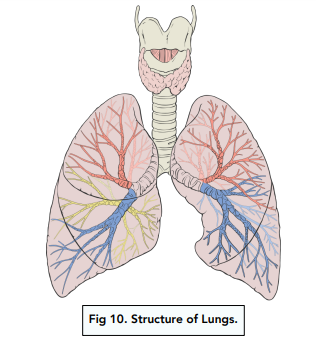
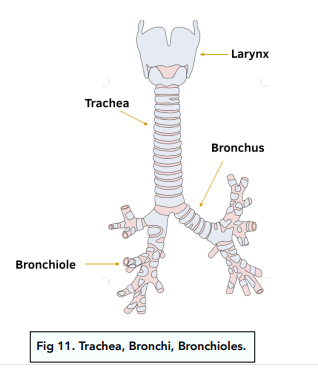
Other Surrounding Structures
There are other important structures surrounding the lungs too:
- Diaphragm – flat sheet of muscle that separates the abdomen from the thorax
- Ribs – form a cage around the lungs and expand and relax to aid ventilation
- Intercostal Muscles (Internal and External) – Muscles that lie between the ribs
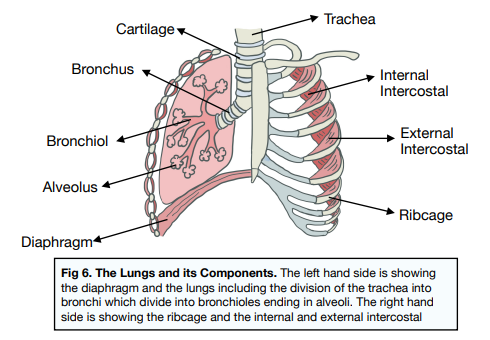
The epithelium of the lungs are also specialised for their functions and there are mainly cells of 2 types:
- Goblet cells – these cells secrete mucus. They line the airways and constantly produce mucus which traps any harmful/ irritating substances that may have been inhaled.
- Ciliated cells – these are cells with tiny hair-like structures on their surface. These ‘hairs’ move together to help waft the mucus (secreted by the goblet cells) back up the airways towards your throat
Adaptations of Alveoli
The alveoli are well adapted for gas exchange:
- Large surface area – the whole collection of alveoli gives the lungs a large surface area, and each alveolus also has a large surface area itself. This speeds up the rate of gas exchange.
- Thin walls – the alveoli have a very thin wall, which reduced the diffusion distance
- Constant blood supply – the alveoli have a constant supply of blood as they are closely associated with pulmonary capillaries. This means that the concentration gradient is always maintained, as new, fresh
deoxygenated blood is always arriving, and oxygenated blood is carried away
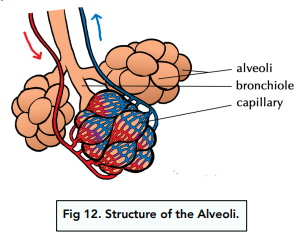
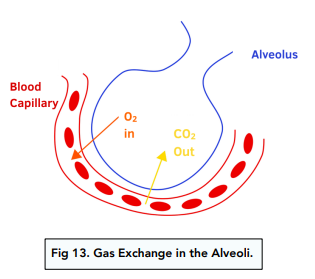
- Constant ventilation – the lungs constantly move air in and out, which also helps to maintain the concentration gradient. New, fresh oxygenated air is always arriving during inhalation.
The lungs themselves have some adaptations. For example, the trachea has cartilage to help keep it open at all times (if it closed, you would be at risk of dying!). The trachea, and bronchi also have mucus and ciliated epithelium to trap and move dust and bacteria, preventing infections.
Ventilation in Mammals
Ventilation is the process of breathing in and out in mammals. It is when air is constantly moved in and out of the lungs to maintain a concentration gradient so that gases can diffuse across the alveolar epithelium.
Inspiration is the process of breathing in. This air is composed of oxygen, little carbon dioxide and little water vapour.
Expiration is the process of breathing out. This air is composed of little oxygen, more carbon dioxide and more water vapour.
You can use a limewater test for carbon dioxide to investigate the differences in composition between inspired and expired air. This test uses a solution of calcium hydroxide and when carbon dioxide is bubbled through, it will turn milky/ cloudy.
Movement of Air
The movement of air into and out of the lungs is due to the volume and pressure changes inside the lungs. These changes are due to the movement of 3 sets of muscles:
- Diaphragm – this is a flat sheet of muscle that separates the thorax from the abdomen.
- Internal intercostal muscles – these muscles lie between the ribs and are positioned towards the inside of the ribcage.
- External intercostal muscles – these muscles lie between the ribs and are positioned towards to outside of the ribcage.
Inspiration
This is an active process. Energy is required to contract the muscles in order to move the ribcage.
The steps below explain the process of inspiration along with the volume and pressure changes in the thorax:
- External intercostal muscles contract, internal intercostal muscles relax. This causes the ribcage to move up and out. This increases the volume in the thorax.
- The diaphragm contracts and flattens. This also increases the volume in the thorax.
- Pressure in the lungs is reduced. As the volume in the thorax increases, the pressure decreases.
- Air is forced into the lungs. This is because the pressure in the lungs is lower than the pressure of the atmosphere. Air moves from an area of high pressure to an area of low pressure so air from the atmosphere moves into the lungs.
Expiration
This is a largely passive process. Not much energy is required as muscles are mainly relaxing.
The steps below explain the process of expiration along with the volume and pressure changes:
- Internal intercostal muscles contract, external intercostal muscles relax. This causes the ribcage to move down and in. This decreases the volume in the thorax.
- The diaphragm relaxes and moves back up. This also decreases the volume in the thorax.
- Pressure in the lungs is increased. As the volume in the thorax decreases, the pressure increases.
- Air is forced out of the lungs. This is because the pressure in the lungs is higher than the pressure of the atmosphere. Air moves from an area of high pressure to an area of low pressure so air from the
lungs moves out into the atmosphere.
Effects of Physical Activity
Physical activity will of course have an effect on your breathing.
- When you exercise, your body needs more oxygen and produces more carbon dioxide
- The brain detects this increase in carbon dioxide in the blood
- The brain signals to increase the rate and depth of your breathing
- This sends more oxygen to your muscles
You can investigate this yourself by measuring how many breaths you take in a minute before and after exercise and use a spirometer to measure the depth of breathing.
The lungs are two spongy, air-filled organs located in the chest that are responsible for breathing and exchanging oxygen and carbon dioxide in the body.
When you inhale, air is taken into the lungs through the nose or mouth and then travels down the trachea into the bronchi. The air then moves into the tiny air sacs in the lungs, called alveoli, where oxygen is absorbed into the bloodstream and carbon dioxide is expelled.
The diaphragm is a muscular sheet that separates the chest and abdomen and helps control breathing. When you inhale, the diaphragm contracts and moves downward, creating more space in the chest cavity. This allows air to flow into the lungs. When you exhale, the diaphragm relaxes and moves upward, expelling air from the lungs.
Oxygen is a colorless, odorless gas that is essential for life. When we inhale oxygen, it is transported to the cells in our bodies, where it is used in a process called cellular respiration to produce energy.
Carbon dioxide is a waste product produced by cells in the body during cellular respiration. When we exhale, we expel carbon dioxide from our bodies.
Asthma is a chronic lung disease that causes inflammation and narrowing of the airways, making it difficult to breathe. Symptoms of asthma include wheezing, coughing, chest tightness, and shortness of breath. People with asthma need to take medication and follow their asthma action plan to manage their symptoms and prevent attacks.
These questions and answers provide a comprehensive introduction to the lungs, making it easier for 15-16 year old students to understand this important concept as they study GCSE biology.






Still got a question? Leave a comment
Leave a comment